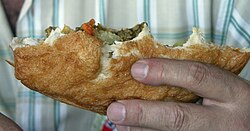Vetkoek
This article needs additional citations for verification. (July 2015) |
 Vetkoek filled with ground beef | |
| Alternative names | Amagwinya |
|---|---|
| Type | Fried dough |
| Place of origin | South Africa |
| Main ingredients | Dough Sweet filling: syrup, honey, or jam Savoury filling: minced beef |

Vetkoek /ˈvɛt.kʊk/ is a traditional South African fried dough bread common in Afrikaner cookery. It is either served filled with cooked mince (ground beef) or with syrup, honey, or jam. It is thought to have its origins from the Dutch oliebollen, which date from the time of the migration period. It is similar in taste to Mexican sopapillas.[1]
The word "vetkoek" literally means "fat cake". It is similar in shape to a doughnut without a hole, and is made from flour, salt and yeast. Dough is rolled into a ball then deep fried. In a traditional South African braai, or barbecue, vetkoek may be served alongside boerewors. Koeksisters are made from a similar, but sweeter, dough but are braided in long strips then coated in a sticky sweet syrup. Vetkoek is commonly sold at family owned take away restaurants and Afrikaans festivals and cultural events.
Amagwinya
Similar to a vetkoek, the amagwinya is a popular meal for many people living in townships. The term amagwinya originates from the historically Black townships of Gauteng in South Africa. Amagwinya differ from the vetkoek in that amagwinya are never filled like the traditional vetkoek; but are served plain and hot with an optional variety of piquant, umami and salty side dishes such as portions of Cape snoek fish, mango atchar, sausage and salted fried potato chips. The popularity of this food item is evidenced by the many spaza shops, hawkers at taxi ranks, roadside vendors, and fast food shops located in the Gauteng townships who sell this food.
See also
References
- ^ Henk Werk (January 20, 2014). "Oliebollen" (in Dutch). Home.hccnet.nl. Retrieved 2014-07-13.

